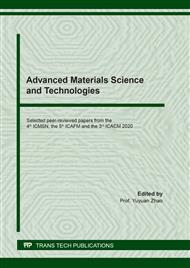p.23
p.31
p.41
p.49
p.56
p.62
p.73
p.83
p.89
Electrospun Polyacrylonitrile-Keratin Derived Carbon Nanofiber as Electrode for Asymmetric Supercapacitor
Abstract:
Electrospinning is one method to produce nanosized materials in a form of fibers with a large variety of polymeric solutions. In this research, Polyacrylonitrile (PAN) dissolved in N,N-Dimethylformamide (DMF) as the primary solvent, loaded with keratin protein solution, was blended using the said fabrication method to change its properties. The loading of the keratin solution concentrates varied from 5%, 7%, and 10% relative to the volume of the solution. The PAN-keratinnano substances were characterized using Fourier Transform Infrared Spectroscopy (FTIR), Scanning Electron Microscopy (SEM), Cyclic Voltammetry (CV), and Galvanostatic Cycling with Potential Limitation (GCPL) to illustrate the properties of the fiber. The SEM micrographs showed that upon adding keratin into the PAN the diameter lengths of the imaged fibers were still nanofiber. As the viscosity of the solution is increased, the beads become bigger, the average distance between beads and the fiber diameter increases, and the shape of the beadings changes from spherical to spindle-like. In addition, CV and GCPL revealed that as the potential scan rate is being increased, the surrounded area of the CV also increases. The presence of redox peaks implies that a faradaic process occurs. The migration and diffusion of ions can be supported by the carbonized fibers. GCPL shows the triangular shape with symmetric charging and discharging slopes at a current density of 0.5mah, 1mah, 1.5mah and 2.5mah, confirming that the electrodes behave as a pure electric double layer capacitor (EDLC).
Info:
Periodical:
Pages:
56-61
Citation:
Online since:
March 2021
Keywords:
Price:
Сopyright:
© 2021 Trans Tech Publications Ltd. All Rights Reserved
Share:
Citation:


